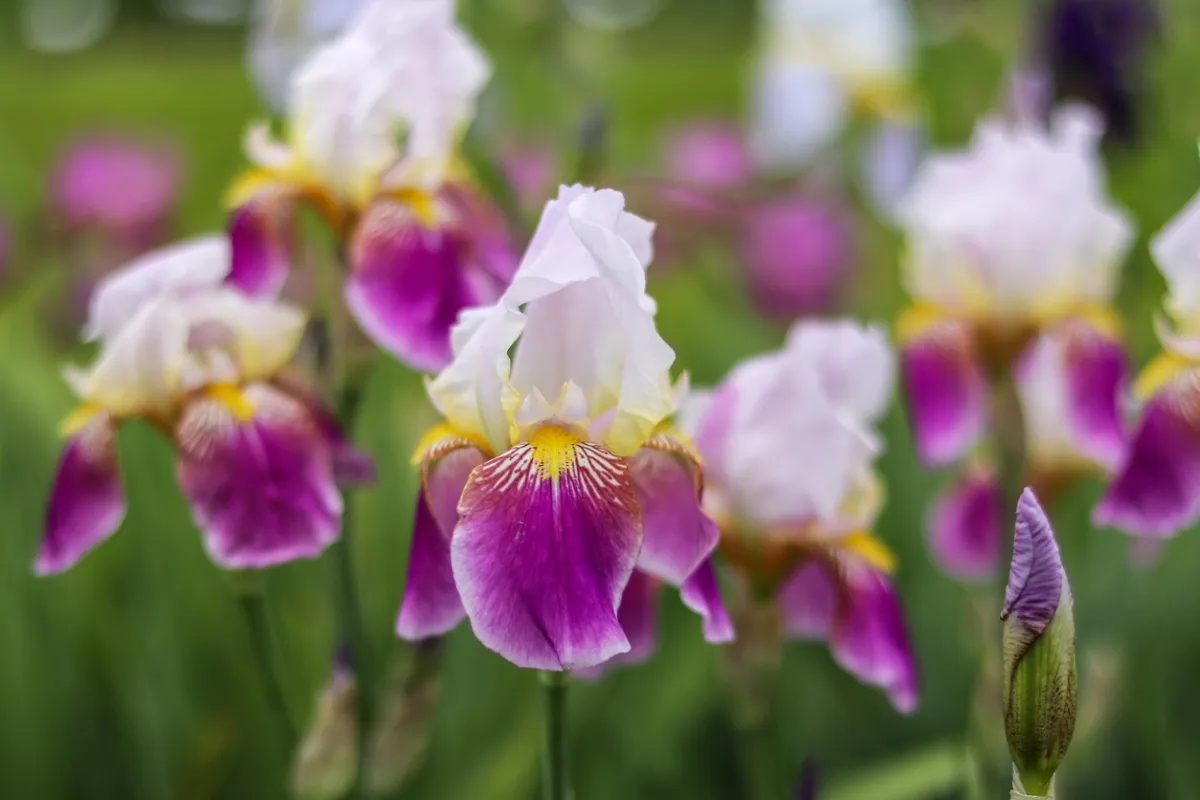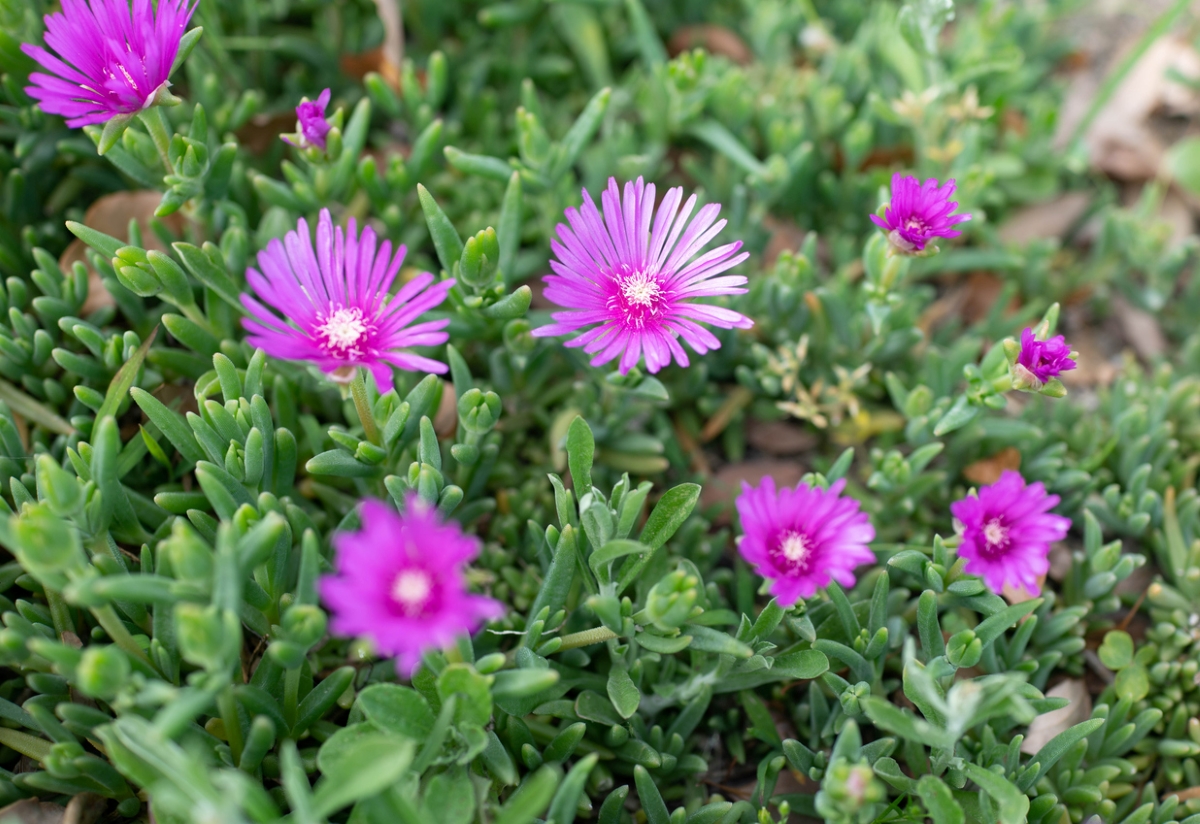We may earn revenue from the products available on this page and participate in affiliate programs. Learn More ›
Remember when droughts were a problem only in hot deserts? Times (and the climate) have changed, and now drought-tolerant plants are appealing to gardeners in other locations. As of January 30, 2024, about 19 percent of the contiguous states were in moderate to exceptional drought. Not only are droughts more common, frequent, and severe than they used to be, they are lasting longer than they did in the past, and affecting areas normally immune to a lack of precipitation.
If you think your region is immune to drought, turn to the U.S. Drought Monitor, a weekly report showing the drought intensity around the country and its territories. Reported conditions range from normal to exceptional drought, and drought conditions cover much more than the Southwest, with severe and exceptional spots near our northern border and in the Midwest.
What can a gardener plant in a drought-prone zone? This list includes a few plants that can replace the thirsty plants in your landscape. It also includes attractive or useful drought-tolerant plants for dry regions, and cover a range of growing zones and conditions. Whichever plants you decide to add to your landscape, remember that all low-water plants need a little extra water in their first year or so, or until they have established roots.
1. Bluebeard (Caryopteris x clandonensis)

Also called blue mist shrub or blue spirea, Caryopteris is a little-known star of the drought-tolerant garden. The shrub, which is related to mints, features fragrant pale-green leaves topped with clumps of bluish-purple flowers in summer. Reaching about 3 to 4 feet high and wide, the shrub takes kindly to pruning and attracts bees and hummingbirds to its flowers.
Bluebeard can handle drought once established and does poorly in heavy, moist soil. Choose a spot with good drainage and plant this easy-care shrub in full sun in USDA Zones 4 to 9.
2. Coneflower (Echinacea purpurea)

Native to central and eastern areas of the U.S., coneflower (Echinacea) is an easy-to-grow perennial that blooms with daisy-like flowers during the summer and fall. Petals come in purple, plus a wide range of bright colors, including yellow, red, pink, orange, and white.
In addition to handling drought well, coneflowers are resistant to problems caused by heat and humidity. Warm Summer echinacea boasts a range of colors on plants that reach more than 2 feet high. Perennials in USDA Zones 3 through 8, echinacea flowers are among low-water plants that attract butterflies and bees; give them full sun and well-draining soil.
3. Sedum (Sedum spp.)

Sedum, also called stonecrop, is one type of succulent that flourishes in dry conditions. The genus includes hundreds of varieties of drought-tolerant perennials, from upright flowering plants to creeping ground covers in a variety of foliage or flower colors.
After you plant one sedum, you’ll soon want more. They are incredibly easy to maintain and grow in Zones 3 to 9 (depending on variety) in clay, loam, or sandy soil. Try an upright Sedum ‘Autumn Joy’ in a garden bed, or the chartreuse ‘Angelina’ in warmer rock gardens or other dry spots.
4. Lavender (Lavandula angustifolia)

Add scent, pollinators, and beautiful flower stalks to a drought-tolerant garden by planting lavender. Plant one just to harvest the summer flowers for their scent or a row for a beautiful hedge that brings bees and butterflies to the garden.
Shining among the small drought-tolerant shrubs, lavender grows in Zones 5 through 9. For those in colder regions, be sure to choose the best variety such as Hidcote. Although too much water can kill a lavender plant, the herb needs regular moisture to get started. Water early in the day, if possible, and place lavender in soil that drains well.
5. Spirea (Spirea spp.)

Once established, spirea can survive both drought and poor soil conditions after the shrub has received a season or so of deep but infrequent waterings. The plant comes in an expansive range of foliage and bloom colors, including pink, white, and yellow. Depending on the variety, spirea thrives in USDA Zones 4 to 8. It’s important to note, however, that Japanese spirea (S. japonica) is considered invasive in areas of the Southeast.
S. nipponica ‘Snowmound’ grows to nearly 4 feet high and is loaded with mounding white flowers in late spring, and Bumald’s spirea are among drought-resistant plants Florida gardeners can plant. If you regularly deadhead spent flowers, spirea will treat you to another bloom later in the season.
6. Limelight Hydrangea (Hydrangea paniculata ‘Limelight’)

Hydrangeas, which grow in Zones 3 through 9, typically don’t make lists of plants that don’t need water, but some varieties, like Limelight, can handle more heat and drought than others. If you live in an area where hydrangeas normally thrive, choose a variety that can handle periods of drought after a few years in the ground. Mulch around the shrub to help it handle droughts, and be sure to plant it where it gets afternoon shade.
Limelight hydrangea grows in USDA Zones 3 to 9, and is festooned with large white flowers that fade to pink or red. Because the plant blooms on fresh growth, gardeners should prune hydrangeas in the winter or early spring.
7. Beautyberry (Callicarpa americana)

The American beautyberry shrub gives four-season appeal to Southeast landscapes, with clumps of dazzling purple berries (a favorite of birds) as the main attraction in winter. The perennial plant is native to wood thickets from the southern Atlantic coast to Oklahoma, but still needs some sun each day.
Once established, American beautyberry is drought-tolerant and can attract all manner of small wildlife. The shrub grows to nearly 5 feet high in USDA Zones 6 through 10, depending on the variety.
8. Bearded Iris (Iris germanica)

Thanks to its unmistakable bloom, bearded iris looks beautiful both in the yard and in a vase. It comes in a wide range of hues and requires minimal upkeep, though you may need to divide the rhizomes every 5 years or so.
Bearded iris varieties range from dwarf (about 8 inches high) to tall (2 to 3 feet high) and are hardy plants that thrive in Zones 3 through 10. Reblooming irises need water all summer, but those that bloom in late spring can handle periods of drought.
9. Creeping Thyme (Thymus serpyllum)

Creeping thyme is a winner among drought-resistant plants. The ornamental, low-growing perennial requires minimal water, and blooms with delicate flowers that are a boon to bees and other pollinators. A popular ground cover, creeping thyme can even be used to replace turf grass in lawns, saving water. Plant it between steps in paths as well; it grows in USDA Zones 5 to 8 in full sun and dry or well-draining soil.
10. Black-Eyed Susan (Rudbeckia hirta)

Rudbeckia, an undemanding biennial to short-lived perennial, will charm all summer long with bright yellow daisy-like flowers. The brown-to-purple centers inspired its common name, black-eyed Susan. The native and most of its hybrids grow in Zones 3 through 8. Rudbeckia is drought-tolerant and disease resistant. Other points in its favor are that its flowers will attract butterflies to the garden, and it can be cut for indoor arrangements.
11. Pachysandra (Pachysandra terminalis)

Pachysandra has long been a popular ground cover, and for good reason: It’s low maintenance, evergreen, and both deer and rabbit resistant. It favors shade, so it’s an excellent choice for landscaping around trees, or as a border or foundation plant in areas that don’t get a lot of sun.
The ground cover also can help slow erosion on slopes with its thick spread by rhizomes in shady areas, a water-saving bonus. Although it grows best in moist, acidic soils, pachysandra can get through periods of drought well in those areas of Zones 4 through 9 that typically get good rainfall.
12. Ice Plant (Delosperma cooperi)

Gardeners in the dry Southwest are familiar with this stunning ground cover. Ice plant offers a cheerful blanket of low-growing, daisy-like flowers, available in a variety of colors thanks to clever hybridizers. Like other succulents, ice plant requires minimal water, and it’s a perennial, so it will bloom year after year in Zones 6 through 10. Give it full sun and plenty of room to spread, especially over rocks or walls.
13. Hollyhock (Alcea rosea)

Because hollyhocks originated around the Mediterranean, they’re ideal as drought-resistant flowers. Seeds put forth tall, elegant flowers in a variety of colors and will self-seed easily. Hollyhocks fit well in a sunny cottage garden, but also stun when growing in front of a wall or fence in drought-prone regions of USDA Zones 2 through 10.
14. Fountain Grass (Pennisteum spp.)

When planted in groups, fountain grass adds a beautiful, dramatic touch to a drought-tolerant landscape. The graceful plant comes in various colors, and its feathery blooms bring attention-grabbing texture and interest to a yard or containers.
Some are more hardy than others, but you can find a type of fountain grass to grow from Zone 4 to Zone 10. Or grow a stunner like purple fountain grass (P. setaceum ‘Rubrum’) as an annual in Zones 9 and 10. Because fountain grass thrives in dry soil conditions, it can be a fine option for a drought-tolerant garden once it’s established.
15. Chocolate Flower (Berlandiera lyrata)

Also named chocolate daisy, Berlandiera is a wildflower native to the Southern Plains and Southwest, so it’s among drought-resistant plants Texas gardeners can enjoy. The delicate yellow flowers feature chocolate-colored centers, which is striking enough. But this drought-tolerant native flower also smells like chocolate. It’s hardy enough to thrive in clay, loam, sand, or rocky soil and to thrive in USDA Zones 4 through 10. Chocolate flower is deer-tolerant and attracts pollinators. The only thing chocolate flowers can’t take is acidic soil.
A long taproot makes this perennial sensitive to transplanting, but it can reseed from wind-carried seeds at the end of the season. The plant can flower from spring through fall in full sun, especially if the spent flowers are deadheaded.
16. Yarrow (Achillea millefolium)

Yarrow attracts a variety of butterflies, which land on the nearly flat flower cluster from summer to early fall. The drought-tolerant flowers of yarrow need weekly deep watering during peak summer heat. Grow it in full sun in well-draining soil in USDA Zones 3 to 9. The plant can appear weedy in formal gardens, but is an excellent plant for natural landscapes and rock gardens, or planted in large groups for a meadow effect. Deadhead spent yellow, white, or red flower clusters or bring them inside as cut flowers.
A type of herb, common yarrows were used for medicinal purposes by Native Americans, and the herb can be used in teas. It’s somewhat toxic to cats, dogs, or horses, however, and some people who handle yarrow report skin rashes or irritation.
17. Rosemary (Rosmariunus officinalis)

Although limited in its hardiness as a perennial (USDA Zones 6 through 8), rosemary is a workhorse of the drought-tolerant garden. The plant grows as an upright shrub or trailing herb, depending on the variety. Delicate, lilac-colored blooms can appear in late winter or early spring, offering a food source for pollinators. Place rosemary in loose soil that drains well and where the plant receives full sun but is near enough to the house for harvesting (and to enjoy its scent).
Gardeners who live in colder climates or who have acidic soil can grow rosemary as a low-fuss, drought-tolerant annual herb. It’s also possible to propagate rosemary with a stem cutting to enjoy again the next summer.


